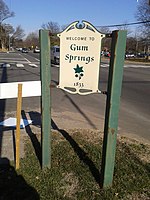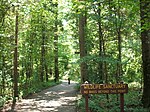Hollin Hills is a historic district and neighborhood in southeast Fairfax County, Virginia. It is located primarily in the Fort Hunt area of the county with some portions remaining in the Hybla Valley and Groveton areas since a shift for census purposes prior to 2010. The community contains more than 30 acres (12 ha) of parkland across seven distinct parks, a pool and swim club, a bocce court, and a pickleball and tennis club, operated and maintained by the Civic Association of Hollin Hills (CAHH).Principally designed by Charles M. Goodman and developed by Robert C. Davenport in the 1940s, it was one of the Washington, D.C. area's first post-war modernist architecture developments, combined with natural landscape designs between 1949–1971. Davenport purchased the original 225 acres (91 ha) of hilly, undeveloped land for $550/acre (present value:$8,254/acre). As home sales and national acclaim grew, he then acquired another 101 acres (41 ha) in 1956, and constructed more homes until the "New Hollin Hills" was completed in 1971. In all, roughly 450 houses with contemporary construction techniques and landscape plans were established in northern Virginia, offsetting the area’s more common Colonial Revival homes. Today, the neighborhood is known primarily for its mid-century modern architecture homes, each is uniquely oriented on its lot to maximize its privacy and landscape view, with sight lines intentionally chosen to enhance the common space shared by each structure. These design tenets have remained very cohesive because of a long-standing design review committee that advises on building or modification of existing houses, and starting in 2022, its designation as the Hollin Hills Historic Overlay District (HOD), which requires modifications and additions to be reviewed by Fairfax County Architectural Review Board.The Hollin Hills Historic District is a 326 acres (132 ha) residential neighborhood encompassing 468 contributing buildings, five contributing sites, and three contributing structures for its 2013 designation in the Virginia Landmarks Register and the National Register of Historic Places. The boundaries of Hollin Hills reflect the initial purchase of the 225 acres in 1946 as the site for a residential suburb and the neighborhood’s 1956 expansion by Robert Davenport that added 101 acres to the southwest of the original section. The historic district encompasses all of the present 326 acres (132 ha) of Hollin Hills, composed of single-family dwellings, parks, and recreational areas.Residents have Alexandria mailing addresses with ZIP codes 22306 or 22307.











